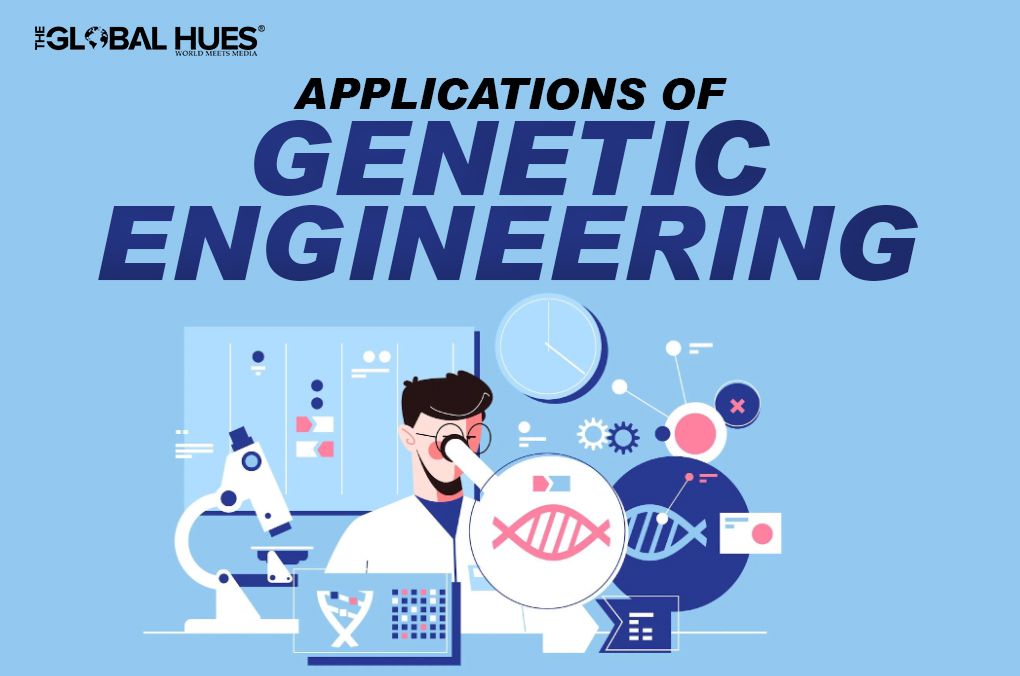In biotechnology, genetic engineering refers to the practice of making precise changes to an organism’s DNA. To introduce foreign DNA into an organism’s genome, scientists must first isolate and clone the target DNA using molecular cloning techniques or synthesize the DNA and insert the resulting “construct” into the host’s genome. Genes can be “knocked out” (removed) with the use of a nuclease.
Gene targeting is a new method for altering an endogenous gene by homologous recombination, and it can be used to accomplish things like removing exons, adding genes, or even introducing point mutations. Genetic engineering enables the modification of various living things, such as plants, animals, and microbes, for use in a variety of industries and fields, including agriculture, science, and health.
Many pharmaceuticals and hormones with therapeutic abilities have been developed through genetic engineering. Gene splicing was first put to use in the pharmaceutical industry to produce massive quantities of insulin from E. coli bacteria. Tissue plasminogen activator and urokinase, both of which are used to dissolve blood clots, are also products of genetic engineering, as is interferon, which is used to eradicate specific viruses and kill cancer cells.
In this article, we will talk about the applications of genetic engineering across different fields, such as medicine and treatments, agriculture, energy production, etc. Here goes the different types of applications of genetic engineering-

Agriculture
Changing the genotype of crop plants through recombinant DNA technology has the potential to increase their production, improve their nutritional value, increase their protein content, make them more resistant to disease, and reduce their need for fertilizer, among other benefits. High-yielding grains, pulses, and vegetable crops are now possible because of recombinant DNA technology and tissue culture techniques.
High-protein grains with potential tolerance to heat, moisture, and diseases have been engineered in several plants. Some plants have been genetically modified to produce their own pesticides, and others may develop their own fertilizers. The need for fertilizers has been eliminated thanks to genetically engineered varieties that can fix atmospheric nitrogen directly.
Transgenic potatoes, tobacco, cotton, corn, strawberry, and rapeseed are resistant to insect pests and some weedicides thanks to scientific research.
Several genetic engineering methods are being used to improve a variety of agricultural crops, and here are some measures that have been taken to help the agriculture sector move forward in this world of technology-
- Gene transfer from leguminous plants legumes to cereals in order to fix nitrogen in the soil.
- Transplantation of disease and pest-resistant genes from wild plants into agricultural crop plants.
- The number and quality of seed proteins have increased.
- Animal genes have been transferred to plant crops to transform them into a source of animal protein.
- Removal of disease-causing mutations from cytoplasmic male sterile lines of crops like maize, where the genes for both male sterility and disease resistance are contained on the mitochondrial plasmid.
- The efficiency of photosynthesis can be increased by switching from C3 to C4 photosynthesis and by reassembling genes in the nucleus and chloroplasts.
- The creation of cell lines that could be used to cultivate food in bioreactors.
Medicines and Clinical Treatments
The prevalence of genetic diseases and the reduction of agricultural lands have both increased the importance of genetic engineering in recent years, and both trends are expected to continue in the present century. The development of pharmaceuticals is greatly aided by genetic engineering.
Drugs, vaccines, enzymes, and hormones can now be mass-produced at low cost by manipulating microorganisms and plant-based compounds. The goal of genetic engineering is to create a complete blueprint for healthy human inheritance through the study (and collecting) of human genes.
Perhaps the most groundbreaking and hopeful part of genetic engineering is gene therapy, in which healthy genes are inserted directly into a person with faulty genes. More than 400 clinical trials have been conducted using gene therapy to treat conditions such as cystic fibres emphysema, muscular dystrophy, and adenosine deaminase deficiency.
In the future, gene therapy could be utilized to treat and even reverse genetic disorders that affect humans, such as hemophilia and cystic fibrosis. One form of gene therapy uses genetically designed viruses to insert new functional genes into the cells of patients who lack the ability to create essential hormones or proteins.
The recombinant DNA technique allows for the introduction of new genes into an organism, which ultimately affects protein composition and, by extension, overall bodily features.
Vaccines
Vaccines to fight diseases are also manufactured using recombinant DNA technology. Vaccines typically contain infectious strains of pathogenic organisms that still stimulate the immune system into producing antibodies to fight against infective organisms. Antigen, or protein, found on the surface of virus particles is isolated throughout the vaccine development process.
Antigens used in vaccinations against viruses cause the body to develop antibodies that attack and neutralize the virus’s proteins. The Vaccinia virus, which is used to treat smallpox, has had its genes for several viral sheath proteins transferred to it using recombinant DNA technology.
Gene cloning yields safe and effective vaccines because they include only the coat proteins that trigger an immune response. Gene cloning is used to create a small number of vaccines, including those for viral hepatitis, influenza, herpes simplex virus, and animal foot-and-mouth disease.
Lymphokines
Lymphokines are proteins that control the immune system in humans. Hepatitis, herpes, the common cold, and even cancer are all viral disorders that can be treated with interferon, which is an example of a lymphokine. Large quantities of these medicines can be produced in bacterial cells.
Patients with AIDS may also benefit from lymphokines. Interleukin-II, a chemical that promotes lymphocyte proliferation, has been genetically modified and is currently being tried on AIDS patients.
Hormones
Until recently, the pancreas of cows and pigs was the only source of the hormone insulin. It was expensive, and the hormone could trigger allergic reactions in some diabetic people.
The Food and Drug Administration of the United States granted permission for the use of the hormone insulin for medical purposes in 1982, and commercial production of insulin using biogenetic or recombinant DNA technology started that same year.
The cloning of the human insulin gene into the bacteria E. coli opens the possibility of insulin production. Humilin is the brand name for genetically modified insulin.
Cancer
Cancer is dreaded by mankind all over the world. In the fight against cancer, monoclonal antibodies—antibodies cloned from a single donor and engineered to recognize a single antigen—have proven to be highly effective. Radiation or cytotoxins like Ricin from castor seed have been added to monoclonal antibodies to increase their lethality. These antibodies target cancer cells and eliminate them through radioactivity or toxicity.
Production of Energy
The potential for energy production with recombinant DNA technology is enormous. Energy crops or biofuels can be bioengineered to grow quickly and produce large quantities of biomass for use as fuel or for further processing into oils, alcohols, diesel, or other energy products with the help of this technology.
Methane can be produced from the byproducts of various processes. In order to turn materials like sawdust and cornstalks into sugar and ultimately alcohol, genetic engineers are working to transfer the gene for cellulase to the appropriate organisms.
Industrial Applications
Genetically engineered bacteria are used to produce chemicals for industry. Genetically modified microbes allow for the industrial-scale production of a wide range of organic compounds. Enzymes isolated from genetically modified organisms facilitate the conversion of sucrose into glucose.
Thanks to advances in genetic engineering, bacteria and cyanobacteria have been created that can produce ammonia in enormous quantities; this gas is then employed in the production of fertilizers at a fraction of the cost it once did. Scientists are working to create microbes that can break down cellulose into sugar and then ferment the sugar into ethanol.
It is possible to track the breakdown of trash, petroleum products, naphthalene, and other industrial pollutants using recombinant DNA technology.
Final Words
Genetic engineering has brought about a revolution in fields such as medicine, vaccines, and agriculture. Crops can be harvested more efficiently and conveniently by using genetically modified seeds or organisms, and using genetic mapping to form different medicines and vaccines is helping people deal with a wide range of chronic diseases, as well as genetic diseases, that were previously considered incurable or fatal. Genetic engineering is helping mankind put on fight, even against cancer. Genetic engineering also significantly aids in industrial production and energy production. A lot of research is still ongoing, after which it can help mankind even more in the aforementioned aspects and achieve amazing feats going forward.




